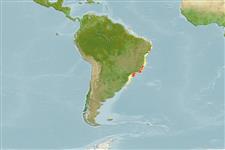>
Ovalentaria/misc (Various families in series Ovalentaria) >
Opistognathidae (Jawfishes)
Etymology: Opistognathus: Greek, opisthe = behind + Greek, gnathos = jaw (Ref. 45335); to the very elongate upper jaw of the type species of the genus, Opistognathus nigromarginatus (Ref. 128653); brasiliensis: Named after Brazil, along whose coast this species appears to be endemic (Ref. 26893).
Environment: milieu / climate zone / depth range / distribution range
Ecologia
marinhas demersal; intervalo de profundidade 15 - 69 m (Ref. 129348). Subtropical
Southwest Atlantic: Brazil.
Tamanho / Peso / Idade
Maturity: Lm ? range ? - ? cm
Max length : 12.9 cm SL macho/indeterminado; (Ref. 26893)
Descrição suscinta
Chaves de identificação | Morfologia | Morfometria
Espinhos dorsais (total) : 11; Raios dorsais (total) : 16; Espinhos anais: 3; Raios anais : 15 - 16; Vértebras: 28. Anterior nostril a short tube with simple cirrus on posterior rim; posterior end of maxilla of adult males produced as a thin flexible lamina that usually extends beyond posterior margin of opercle; spinous dorsal fin with black spot encircled by a very narrow white ring; dorsal fin with 5 or 6 dusky bands that extend onto dorsum; adult males with inner lining of maxilla and adjacent membranes with 2 dark stripes, one stripe in females; pectoral fin uniformly pigmented, no black speckles proximally; buccal pigmentation consisting of a dark area widely surrounding esophageal opening except for a pale area posteriorly that continues between upper pharyngeal tooth patches; caudal vertebrae 8 (Ref. 26893).
Founf on bottoms with gravel and sand or on silt and sand bottoms, near coral reefs and rocky areas (Ref. 129348). Mouthbrooders (Ref. 240).
Ciclo de vida ou comportamento de acasalamento
Maturities | Reprodução | Spawnings | Egg(s) | Fecundities | Larvas
Employ mouthbrooding to care for their young (Ref. 240).
Smith-Vaniz, W.F., 1997. Five new species of jawfishes (Opistognathus: Opistognathidae) from the western Atlantic ocean. Bull. Mar. Sci. 60(3):1074-1128. (Ref. 26893)
Status na Lista Vermelha da UICN (Ref. 130435)
Ameaça para os humanos
Harmless
Uso pelos humanos
Ferramentas
Relatórios especiais
Baixar XML
Fontes da internet
Estimates based on models
Preferred temperature (Ref.
123201): 20.2 - 23.1, mean 21.7 °C (based on 5 cells).
Índice de diversidade filogenética (Ref.
82804): PD
50 = 0.5000 [Uniqueness, from 0.5 = low to 2.0 = high].
Bayesian length-weight: a=0.00389 (0.00180 - 0.00842), b=3.12 (2.94 - 3.30), in cm total length, based on all LWR estimates for this body shape (Ref.
93245).
Nível Trófico (Ref.
69278): 3.5 ±0.6 se; based on size and trophs of closest relatives
Fishing Vulnerability (Ref.
59153): Low vulnerability (10 of 100).
